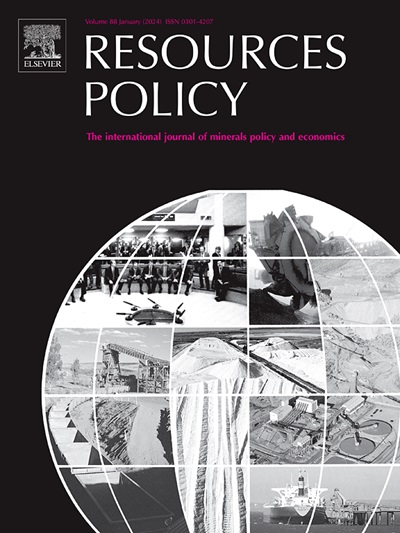Geopolitical risks, critical materials and energy transition: Insights from wavelet analysis
IF 10.2
2区 经济学
0 ENVIRONMENTAL STUDIES
引用次数: 0
Abstract
This paper investigates how the prices of selected energy transition-related commodities respond to geopolitical risks, with particular attention to the suitability of a widely used geopolitical risk index in relation to the commodities included in the dataset. From a methodological perspective, the analysis is conducted via a wavelet-based method. The dataset includes natural gas, copper, palladium, and cobalt futures prices, whose time series cover a fourteen-year time span (2010-2024), while geopolitical risk is measured through the well known text-based geopolitical risk (GPR) index by Caldara and Iacoviello. The study is supported by an in-depth geopolitical discussion, analyzing events and dynamics relevant to the current international context. Our investigation shows different degrees of correlation between geopolitical risk and the above-mentioned commodities. From an overall perspective, commodities with a long-standing history of application tend to exhibit a more straightforward connection with geopolitical dynamics. In contrast, those that have recently gained prominence in the energy transition — especially newer entrants — show weaker and less consistent signals. In this respect, despite its widespread use in the literature, we infer that the GPR index has certain limitations when used to explain dynamics affecting rare and critical elements — particularly those sourced from geographical areas that are not regularly covered by mainstream media. The issue of the GPR index’s adequacy in such contexts appears to be largely overlooked in current academic sources. Recognizing that the energy transition is driving a paradigm shift from a geostrategic standpoint requires a critical awareness when employing such indexes. At the same time, it calls for rethinking how risk indexes are designed, so that they better reflect geopolitical phenomena linked to the new centers of gravity emerging from the energy transition. The results are directed towards policymakers and regulators, who are called upon to govern the energy transition with a focus on the availability of critical materials in the coming decades.
地缘政治风险、关键材料和能源转型:来自小波分析的见解
本文研究了选定的能源转型相关商品的价格如何对地缘政治风险做出反应,特别关注与数据集中所包含的商品相关的广泛使用的地缘政治风险指数的适用性。从方法学的角度来看,分析是通过基于小波的方法进行的。数据集包括天然气、铜、钯和钴的期货价格,其时间序列涵盖了14年的时间跨度(2010-2024年),而地缘政治风险是通过Caldara和Iacoviello的著名的基于文本的地缘政治风险(GPR)指数来衡量的。该研究得到了深入的地缘政治讨论的支持,分析了与当前国际背景相关的事件和动态。我们的调查显示,地缘政治风险与上述商品之间存在不同程度的相关性。从整体来看,具有长期应用历史的商品往往与地缘政治动态表现出更直接的联系。相比之下,那些最近在能源转型中获得突出地位的企业——尤其是新进入者——表现出的信号更弱、更不一致。在这方面,尽管GPR指数在文献中被广泛使用,但我们推断,当用于解释影响稀有和关键元素的动态时,特别是那些来自主流媒体不经常报道的地理区域的动态,GPR指数有一定的局限性。在这种情况下,GPR指数的充分性问题似乎在目前的学术资料中基本上被忽视了。从地缘战略的角度来看,认识到能源转型正在推动范式转变,需要在使用这些指数时具备批判性意识。与此同时,报告呼吁重新思考风险指数的设计方式,以便更好地反映与能源转型中出现的新重心相关的地缘政治现象。研究结果是针对政策制定者和监管机构的,他们被要求在未来几十年管理能源转型,重点关注关键材料的可用性。
本文章由计算机程序翻译,如有差异,请以英文原文为准。
求助全文
约1分钟内获得全文
求助全文
来源期刊

Resources Policy
ENVIRONMENTAL STUDIES-
CiteScore
13.40
自引率
23.50%
发文量
602
审稿时长
69 days
期刊介绍:
Resources Policy is an international journal focused on the economics and policy aspects of mineral and fossil fuel extraction, production, and utilization. It targets individuals in academia, government, and industry. The journal seeks original research submissions analyzing public policy, economics, social science, geography, and finance in the fields of mining, non-fuel minerals, energy minerals, fossil fuels, and metals. Mineral economics topics covered include mineral market analysis, price analysis, project evaluation, mining and sustainable development, mineral resource rents, resource curse, mineral wealth and corruption, mineral taxation and regulation, strategic minerals and their supply, and the impact of mineral development on local communities and indigenous populations. The journal specifically excludes papers with agriculture, forestry, or fisheries as their primary focus.
 求助内容:
求助内容: 应助结果提醒方式:
应助结果提醒方式:


